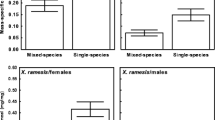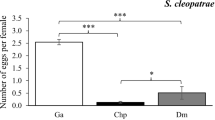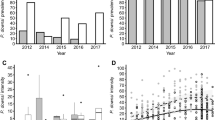Abstract
Evaluating host resistance via parasite fitness helps place host-parasite relationships within evolutionary and ecological contexts; however, few studies consider both these processes simultaneously. We investigated how different levels of parasite pressure affect parasite mortality and reproductive success in relationship to host defense efforts, using the rodent Gerbillus nanus and the flea Xenopsylla conformis as a host-parasite system. Fifteen immune-naïve male rodents were infested with 20, 50, or 100 fleas for four weeks. During this time number of new imagoes produced per adult flea (our flea reproductive output metric), flea mortality, and change in circulating anti-flea immunoglobulin G (our measure of adaptive immune defense) were monitored. Three hypotheses guided this work: (1) increasing parasite pressure would heighten host defenses; (2) parasite mortality would increase and parasite reproductive output would decrease with increasing investment in host defense; and (3) hosts under high parasite pressure could invest in behavioral and/or immune responses. We predicted that at high infestation levels (a) parasite mortality would increase; (b) flea reproductive output per individual would decrease; and (c) host circulating anti-flea antibody levels would increase. The hypotheses were partially supported. Flea mortality significantly increased and flea reproductive output significantly decreased as flea pressure increased. Host adaptive immune defense did not significantly change with increasing flea pressure. Therefore, we inferred that investment in host behavioral defense, either alone or in combination with density-dependent effects, may be more efficient at increasing flea mortality and decreasing flea reproductive output than antibody production during initial infestation in this system.



Similar content being viewed by others
References
Alberts B, Johnson A, Lewis J, Raff M, Roberts K, Walter P (2007) Molecular biology of the cell, 5th edn. Garland Science, Hamden
Bar-Shira E, Sklan D, Friedman A (2003) Establishment of immune competence in the avian GALT during the immediate post-hatch period. Dev Comp Immunol 27:147–157
Bowler M, Messer EJE, Claidière N, Whiten A (2015) Mutual medication in capuchin monkeys-social anointing improves coverage of topically applied anti-parasite medicines. Sci Rep 5:10
Burke ML, Jones MK, Gobert GN, Li YS, Ellis MK, McManus DP (2009) Immunopathogenesis of human schistosomiasis. Parasite Immunol 31:163–176
Butler JM, Roper TJ (1996) Ectoparasites and sett use in European badgers. Anim Behav 52:621–629
Cantarero A, López-Arrabé J, Redondo AJ, Moreno J (2013) Behavioural responses to ectoparasites in pied flycatchers Ficedula hypoleuca: an experimental study. J Avian Biol 44:591–599
Clayton DH, Koop JA, Harbison CW, Moyer BR, Bush SE (2010) How birds combat ectoparasites. Open Ornithol J 3:41–71
Combes C (2001) Parasitism: the ecology and evolution of intimate interactions. University of Chicago Press, Chicago
Cooper J, Gordon I, Pike AW (2000) Strategies for the avoidance of faeces by grazing sheep. Appl Anim Behav Sci 69:15–33
Costa-Neto EM (2012) Zoopharmacognosy, the self-medication behavior of animals. Interfaces Científ-Saúde Ambiente 1:61–72
Craig BH, Pilkington JG, Kruuk LEB, Pemberton JM (2007) Epidemiology of parasitic protozoan infections in Soay sheep (Ovis aries L.) on St Kilda. Parasitology 134:9–21
Crofton HD (1971) A quantitative approach to parasitism. Parasitology 62:179–193
Debeffe L, Morellet N, Verheyden-Tixier H, Hoste H, Gaillard JM, Cargnelutti B, Picot D, Sevila J, Hewison AJM (2014) Parasite abundance contributes to condition-dependent dispersal in a wild population of large herbivore. Oikos 123:1121–1125
Demas GE, Nelson RJ (1998) Photoperiod, ambient temperature, and food availability interact to affect reproductive and immune function in adult male deer mice (Peromyscus maniculatus). J Biol Rhythm 13:253–262
Dlugosz EM, Downs CJ, Khokhlova IS, Degen AA, Krasnov BR (2014) Ectoparasite performance when feeding on reproducing mammalian females: an unexpected decrease when on pregnant hosts. J Exp Biol 217:1058–1064
Downs CJ, Brown JL, Wone B, Donovan ER, Hunter K, Hayes JP (2013) Selection for increased mass-independent maximal metabolic rate suppresses innate but not adaptive immune function. Proc R Soc B 280:2012–2636
El-Bakry HA (2015) Lack of evidence for a trade-off between immune and reproductive systems in a seasonally-breeding desert rodent. Glob Vet 14:500–510
Fernandes FR, Cruz LD, Linhares AX (2012) Effects of sex and locality on the abundance of lice on the wild rodent Oligoryzomys nigripes. Parasitol Res 111:1701–1706
Folstad I, Nilssen AC, Halvorsen O, Andersen J (1991) Parasite avoidance—the cause of post-calving migrations in Rangifer. Can J Zool 69:2423–2429
Forsman AM, Vogel LA, Sakaluk SK, Grindstaff JL, Thompson CF (2008) Immune-challenged house wren broods differ in the relative strengths of their responses among different axes of the immune system. J Evol Biol 21:873–878
Galvani AP (2003) Immunity, antigenic heterogeneity, and aggregation of helminth parasites. J Parasitol 89:232–241
Gilbert KA (1997) Red howling monkey use of specific defecation sites as a parasite avoidance strategy. Anim Behav 54:451–455
Giorgi MS, Arlettaz R, Christe P, Vogel P (2001) The energetic grooming costs imposed by a parasitic mite (Spinturnix myoti) upon its bat host (Myotis myotis). Proc R Soc B 268:2071–2075
Goater TM, Goater CP, Esch GW (2013) Parasitism: the diversity and ecology of animal parasites. Cambridge University Press
Gonçalves RM, Lima NF, Ferreira MU (2014) Parasite virulence, co-infections and cytokine balance in malaria. Pathog Glob Health 108:173–178
Hausfater G, Meade BJ (1982) Alternation of sleeping groves by yellow baboons (Papio cynocephalus) as a strategy for parasite avoidance. Primates 23:287–297
Hawlena H, Bashary D, Abramsky Z, Krasnov BR (2007) Benefits, costs and constraints of anti-parasitic grooming in adult and juvenile rodents. Ethology 113:394–402
Hutchings MR, Gordon IJ, Kyriazakis I, Jackson F (2001) Sheep avoidance of faeces-contaminated patches leads to a trade-off between intake rate of forage and parasitism in subsequent foraging decisions. Anim Behav 62:955–964
Jackson JA, Tinsley RC (2001) Protopolystoma xenopodis (Monogenea) primary and secondary infections in Xenopus laevis. Parasitology 123:455–463
Jokela J, Schmid-Hempel P, Rigby MC (2000) Dr. Pangloss restrained by the Red Queen—steps towards a unified defence theory. Oikos 89:267–274
Kam M, Degen AA, Khokhlova IS, Krasnov BR, Geffen E (2010) Do fleas affect energy expenditure of their free-living hosts? PLoS One 5:e13686
Karvonen A, Seppälä O, Valtonen ET (2004) Parasite resistance and avoidance behaviour in preventing eye fluke infections in fish. Parasitology 129:159–164
Khokhlova IS, Spinu M, Krasnov BR, Degen AA (2004) Immune response to fleas in a wild desert rodent: effect of parasite species, parasite burden, sex of host and host parasitological experience. J Exp Biol 207:2725–2733
Khokhlova IS, Hovhanyan A, Krasnov BR, Degen AA (2007) Reproductive success in two species of desert fleas: density dependence and host effect. J Exp Biol 210:2121–2127
Khokhlova IS, Hovhanyan A, Degen AA, Krasnov BR (2010) The effect of larval density on pre-imaginal development in two species of desert fleas. Parasitology 137:1925–1935
Koop JA, Owen JP, Knutie SA, Aguilar MA, Clayton DH (2013) Experimental demonstration of a parasite‐induced immune response in wild birds: Darwin’s finches and introduced nest flies. Ecol Evol 3:2514–2523
Krasnov BR, Khokhlova IS, Fielden LJ, Burdelova NI (2001) Effect of air temperature and humidity on the survival of pre-imaginal stages of two flea species (Siphonaptera: Pulicidae). J Med Entomol 38:629–637
Krasnov BR, Khokhlova IS, Fielden LJ, Burdelova NI (2002) Time of survival under starvation in two flea species (Siphonaptera: Pulicidae) at different air temperatures and relative humidities. J Vector Ecol 27:70–81
Krasnov BR, Hovhanyan A, Khokhlova IS, Degen AA (2007) Density dependence of feeding success in haematophagous ectoparasites. Parasitology 134:1379–1386
Krasnov BR, Hovhanyan A, Khokhlova IS, Degen AA (2008) Evidence for a negative fitness-density relationship between parent density and offspring quality for two Xenopsylla spp. parasitic on desert mammals. Med Vet Entomol 22:156–166
Lehane MJ (2005) The biology of blood-sucking in insects, 2nd edn. Cambridge University Press, Cambridge
Lochmiller RL, Deerenberg C (2000) Trade-offs in evolutionary immunology: just what is the cost of immunity? Oikos 88:87–98
Mallon EB, Loosli R, Schmid-Hempel P (2003) Specific versus nonspecific immune defense in the bumblebee, Bombus terrestris L. Evolution 57:1444–1447
Martin LB, Han P, Lewittes J, Kuhlman JR, Klasing KC, Wikelski M (2006) Phytohemagglutinin-induced skin swelling in birds: histological support for a classic immunoecological technique. Funct Ecol 20:290–299
Martin LB, Weil ZM, Nelson RJ (2008) Seasonal changes in vertebrate immune activity: mediation by physiological trade-offs. Philos Trans R Soc B 363:321–339
Mears S, Clark F, Greenwood M, Larsen KS (2002) Host location, survival and fecundity of the Oriental rat flea Xenopsylla cheopis (Siphonaptera: Pulicidae) in relation to black rat Rattus rattus (Rodentia: Muridae) host age and sex. Bull Entomol Res 92:375–384
Mooring MS, Samuel WM (1998) The biological basis of grooming in moose: programmed versus stimulus-driven grooming. Anim Behav 56:1561–1570
Mooring MS, Blumstein DT, Stoner CJ (2004) The evolution of parasite-defence grooming in ungulates. Biol J Linn Soc 81:17–37
Moreno-Rueda G (2015) Body-mass-dependent trade-off between immune response and uropygial gland size in house sparrows Passer domesticus. J Avian Biol 46:40–45
Muehlenbein MP, Hirschtick JL, Bonner JZ, Swartz AM (2010) Toward quantifying the usage costs of human immunity: altered metabolic rates and hormone levels during acute immune activation in men. Am J Hum Biol 22:546–556
Norris K, Evans MR (2000) Ecological immunology: life history trade-offs and immune defense in birds. Behav Ecol 11:19–26
Park SJ, Mehrad B (2009) Innate immunity to Aspergillus species. Clin Microbiol Rev 22:535–551
Pitala N, Siitari H, Gustafsson L, Brommer JE (2010) Costs and benefits of experimentally induced changes in the allocation of growth versus immune function under differential exposure to ectoparasites. PLoS One 5:8
Poulin R (2004) Parasites and the neutral theory of biodiversity. Ecography 27:119–123
Poulin R (2011) Evolutionary ecology of parasites, 2nd edn. Princeton University Press, Princeton
Råberg L, Graham AL, Read AF (2009) Decomposing health: tolerance and resistance to parasites in animals. Philos Trans R Soc B 364:37–49
Rauw WM (2012) Immune response from a resource allocation perspective. Front Genet 3:267
Reckardt K, Kerth G (2007) Roost selection and roost switching of female Bechstein’s bats (Myotis bechsteinii) as a strategy of parasite avoidance. Oecologia 154:581–588
Sansonetti PJ (2006) The innate signaling of dangers and the dangers of innate signaling. Nat Immunol 7:1237–1242
Schmid-Hempel P (2003) Variation in immune defence as a question of evolutionary ecology. Proc R Soc B 270:357–366
Sears BF, Snyder PW, Rohr JR (2015) Host life history and host-parasite syntopy predict behavioural resistance and tolerance of parasites. J Anim Ecol 84:625–636
Shostak AW, Scott ME (1993) Detection of density-dependent growth and fecundity of helminths in natural infections. Parasitology 106:527–539
Shostak AW, Walsh JG, Wong YC (2008) Manipulation of host food availability and use of multiple exposures to assess the crowding effect on Hymenolepis diminuta in Tribolium confusum. Parasitology 135:1019–1033
Stanback MT, Dervan AA (2001) Within-season nest-site fidelity in Eastern Bluebirds: disentangling effects of nest success and parasite avoidance. Auk 118:743–745
Taylor LH, Mackinnon MJ, Read AF (1998) Virulence of mixed-clone and single-clone infections of the rodent malaria Plasmodium chabaudi. Evolution 52:583–591
Thiessen DD (1988) Body temperature and grooming in the Mongolian gerbil. Ann N Y Acad Sci 525:27–39
Ujvari B, Madsen T (2006) Age, parasites, and condition affect humoral immune response in tropical pythons. Behav Ecol 17:20–24
Vatschenok VS (1988) Fleas: vectors of pathogens causing diseases in humans and animals, Nauka, Leningrad, USSR (in Russian)
Waite JL, Henry AR, Owen JP, Clayton DH (2014) An experimental test of the effects of behavioral and immunological defenses against vectors: do they interact to protect birds from blood parasites? Parasit Vectors 7:104
Warton DI, Hui FKC (2011) The arcsine is asinine: the analysis of proportions in ecology. Ecology 92:3–10
Acknowledgments
We thank Sergei Burdelov and Asal Kattel for technical assistance as well as the anonymous reviewer for helpful comments. This study was supported by the Israel Science Foundation (grant number 927/13 to AAD, MK, ISK, LK, EG, and RF, and grant number 26/12 to BRK and ISK,). EMW received financial support from the United States-Israel Educational Foundation (USIEF Fulbright Post-Doctoral Fellowship) as well as the Swiss Institute for Dryland Environmental and Energy Research. DK received financial support from the Blaustein Center for Scientific Cooperation. This is publication number 903 of the Mitrani Department of Desert Ecology.
Author information
Authors and Affiliations
Corresponding author
Rights and permissions
About this article
Cite this article
Warburton, E.M., Kam, M., Bar-Shira, E. et al. Effects of parasite pressure on parasite mortality and reproductive output in a rodent-flea system: inferring host defense trade-offs. Parasitol Res 115, 3337–3344 (2016). https://doi.org/10.1007/s00436-016-5093-3
Received:
Accepted:
Published:
Issue Date:
DOI: https://doi.org/10.1007/s00436-016-5093-3




